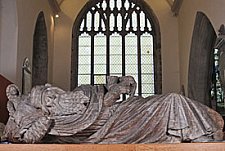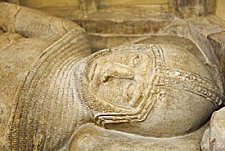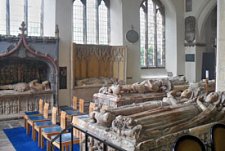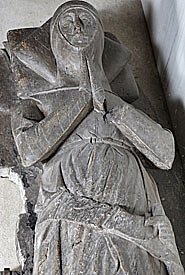HISTORIC MONUMENTS at St Mary's Parish Church, St Mary's Priory, Abergavenny
The church houses many historically important monuments including the following:
Jesse
 |
This extraordinary larger-than-life figure once formed the base of an intricate and elaborate construction, which depicted the lineage of Jesus Christ from Jesse, the father of King David.
So called ‘Jesse figures’ and ‘Jesse trees’ are not uncommon in stone and stained glass, but this is the only one in wood to be found in the United Kingdom – and probably the world.
In the BBC series 'A History of British Art', Andrew Graham Dixon described it as ‘the only great wooden figure to survive the wreckage of the British Cultural Revolution’. Jesse also featured in the more recent BBC series 'The History of Welsh Art'.
We do not know who carved it, but we do know that it retains its extraordinary command of our attention and fascination. Carved from one solid piece of oak, probably in the 15th century, it was originally highly coloured and depicted all the Davidic kings and descendants, surmounted by the figures of Mary and the Child, and Christ in glory.
Latest thought estimates the height of the ‘tree’ growing from Jesse’s side to have been between 25ft and 30ft.
Sir William de Hastings
 |
The stone tomb in the window recess to the south of the chapel is presumed to be that of Sir William de Hastings, brother to and companion to Sir Lawrence de Hastings. Died in the Black Death Plague in 1348.
A Hastings lady
Another petite effigy in the chancel is that of an Hastings lady who is believed to be Margaret Plantagenet, wife of John de Hastings. She is known as the squirrel lady and fell to her death from the ramparts of Abergavenny Castle.
Choir & Sanctuary
The finely carved 15th Century monastic choir stalls were once separated from the nave by a rood screen. The name Wynchester indicates their dating, and it is clear that they were introduced into the church by the Herbert family under sponsorship from King Henry VII. There is a misericord on the south side depicting the Tudor Rose and Prince of Wales feathers dedicated to Prince Arthur, eldest son of King Henry VII. Opposite on the north side of the stalls is Catherine of Aragon’s seat.
Herbert Chapel
The Herbert Chapel (dedicated to St Benedict) contains the greater part of the church's collection of monuments. Three stunning monuments are evidence of the Renaissance English School of alabaster carving.
Monument to William & Joan Baker
 |
This 17th Century tomb shows William and Joan kneeling at prayer. It is elaborately and beautifully carved in local stone, and it is thought that the artist carried out the work 'in situ'.
William ap Thomas and Gwladys
Sir William was a successful Welsh squire who fought at Agincourt with Henry V (where Gwladys’ father, Sir David Gam, and her first husband, Sir Robert Vaughan, died). William (scion of the Herbert dynasty) was later knighted, became rich and powerful, and built the Yellow Tower at Raglan Castle. The Herberts prospered greatly by supporting King Edward IV.
Sir Richard Herbert of Coldbrook
On the north side of the Chapel is the tomb of Sir Richard Herbert and his wife Margaret, who lived at Coldbrook, one of the finest fortified mansions in Wales, which survived until just before the Second World War. He, with his brother William Herbert, were prominent in the wars of the roses and they were both beheaded at the battle of Edgecote. They had discovered Henry Tudor, later Henry VII, and brought him up at Raglan Castle in their guardianship.
Sir Richard Herbert of Ewyas
The impressive alabaster monument encased within an elaborate window arch on the south side of the chapel is that of Sir Richard Herbert of Ewyas, natural son of Sir William Herbert, first Earl of Pembroke, and himself a son of Sir William ap Thomas and the Lady Gwladys. He was brought up with Henry Tudor at Raglan Castle, and later assisted Henry VII when he returned to Wales and claimed the throne of England after the battle of Bosworth.
Judge Andrew Powell and his wife Margaret
These two very worn figures complete the collection of Herbert tombs. They are presentations of Judge Andrew Powell and his wife Margaret who was connected to the Herbert family.
Effigy of Sir John De Hastings
 |
A further great wooden figure is that of Sir John de Hastings, dating from c.1325. This beautifully carved figure was for many years associated with George de Cantiloupe.
More recently, it has been clearly identified as being that of the man who most significantly contributed to the 14th century rebuilding of the Priory.
The newly constructed tomb on which the figure lies contains panelling from the knight’s original tomb, which would have stood at the centre of the choir. Depressions on the side once held brightly enamelled heraldic shields. The cross-legged posture was a fashion popular before 1330 or 1340 and his feet rest on a lion, a symbol of courage and strength.
Eva de Braose
In the Chancel is the heart tomb of Eva de Braose, who died in 1246, her effigy bearing a shield decorated with the Cantilupe fleurs de lis. It is the oldest monument in the church.
Sir Lawrence de Hastings
Sir Lawrence de Hastings was the 13th Lord of Abergavenny, who died in 1348 during the Black Death Plague. He was a distinguished soldier, indicated by his armour, and he fought at the Battle of Sluys and at Crecy in the Hundred Years War.
Dr David Lewis
Dr David Lewis (d.1584) was a local man who achieved fame by becoming an advisor to Queen Elizabeth I and was appointed first principal of Jesus College, Oxford.
It is from Dr Lewis that the Lewis Chapel (dedicated to St Joseph) takes its name. He was the eldest son of Sir Lewis ap John (alias Wallis), Vicar of Abergavenny, and chose to take his father’s Christian name after the Welsh practice.
He was a man of his age and one of great academic distinction. He was elected a Fellow of All Souls College, Oxford, in 1541, and was awarded the degree of Doctor of Civil Law. He was one of the founders and first principal of Jesus College, as well as being appointed Judge of the High Court of Admiralty, Master of St Catherine’s Hospital, London, and one of the Masters in Chancery. He was MP for Monmouthshire in 1554. He died in 1584 in London, and his body brought to Abergavenny to be buried beneath a tomb that he had commissioned from the Herefordshire sculptor, John Gideon, during his lifetime.
